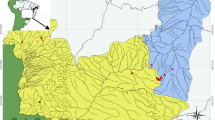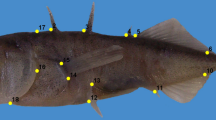Abstract
In the present study, we studied the morphological variations in four populations of Oxynoemacheilus angorae distributed in three basins of Turkish inland waters using a geometric morphometric technique. For this purpose, a total of 55 specimens were collected from the Kızılırmak, Sakarya and Marmara basins. To extract body shape data, the left side of the specimens was photographed, and 15 landmark points on the 2D pictures were defined and digitized. After generalized procrustes analysis, the body shape data were analyzed using multivariate analyses, such as principal component analysis, canonical variation analysis and cluster analysis. The deformation grids were used to show how the body shape changed. Based on the results, two groups, namely Nevşehir and Ankara, by having a deeper body and head and a somewhat longer caudal peduncle, and Yalova and Eskişehir due to lower body and shorter caudal peduncle were clustered. Based on the results, O. angorae adapts itself to different habitats by adjusting head and body depth and caudal peduncle length based on habitat parameters.









Similar content being viewed by others
Data Availability
The data that support the findings of this study are available on request from the corresponding author.
References
Adams D, Collyer M, Kaliontzopoulou A, Sherratt E (2021) Geomorph: software for geometric morphometric analyses. R Package Version 3(2):1
Barlow GW (1961) Social behavior of the desert pupfish, Cyprinodon macularius, in the field and in the aquarium. Am Midl Nat 65(2):339–359. https://doi.org/10.2307/2422959
Blake RW (1983) Fish locomotion. CUP Archive, p 77
Bookstein FL (1991) Morphometric tools for landmark data. Geometry and biology. Cambridge University Press, Cambridge, p 435
Cadrin SX, Silva VM (2005) Morphometric variation of yellowtail flounder. ICES J Mar Sci 62(4):683–694. https://doi.org/10.1016/j.icesjms.2005.02.006
Çiçek E, Sungur-Birecikligil S, Fricke R (2015) Freshwater fishes of Turkey: a revised and updated annotated checklist. Bih Biol 9(2):141–157
Çiçek E, Fricke R, Sungur S, Eagderi E (2018) Endemic freshwater fishes of Turkey. Fishtaxa 3(4):1–39
Çiçek E, Eagderi S, Sungur S (2019) Oxynoemacheilus phoxinoides (Erk’akan, Nalbant & Özeren, 2007): a junior synonym of Oxynoemacheilus angorae (Steindachner, 1897). FishTaxa 4(1):13–17
Çiçek E, Sungur S, Fricke R (2020) Freshwater lampreys and fishes of Turkey; a revised and updated annotated checklist 2020. Zootaxa 4809(2):241–270. https://doi.org/10.11646/zootaxa.4809.2.2
Çiçek E, Eigdari S, Sungur S, Secer B (2021) Species of Oxynoemacheilus Bănărescu & Nalbant, 1966 (Actinopterygii: Nemacheilidae) in the Turkish Part of the Kura-Aras River System, with the First Detailed Evidence for the Occurrence of O. bergianus (Derjavin, 1934) and O. cf. elsae Eagderi et al., 2018. Acta Zool Bul 73(2):171–178
Darcy GH (1985) Synopsis of biological data on the sand perch, Diplectrum formosum (Pisces, Serranidae). NOAA Tech Rep Circ NMFS 26:1–21
Donley JM, Dickson KA (2000) Swimming kinematics of juvenile kawakawa tuna (Euthynnus affinis) and chub mackerel (Scomber japonicus). J Exp Biol 203(20):3103–3116
Eagderi S, Esmaeilzadegan E, Madah A (2013) Body shape variation in riffle minnows (Alburnoides eichwaldii De Filippii, 1863) populations of Caspian Sea basin. J Taxon Biosys 5(4):1–8
Eagderi S, Mouludi Saleh A, Poorbagher H (2020) Sexual dimorphism comparison of body shape of Esmaeilius sophiae using geometric morphometric method. J Anim Env 12(4):311–316
Freyhof J, Erk’akan F, Özeren C, Perdices A (2011) An overview of the western Palaearctic loach genus Oxynoemacheilus (Teleostei: Nemacheilidae). Ichthyol Expl Fresh 22(4):301–312
Freyhof J, Yoğurtçuoğlu B, Kaya C (2021) Oxynoemacheilus sarus/, a new nemacheilid loach from the lower Ceyhan and Seyhan in southern Anatolia (Teleostei: Nemacheilidae). Zootaxa 4964(1):123–139. https://doi.org/10.11646/zootaxa.4964.1
Fu C, Cao ZD, Fu SJ (2013) The effects of caudal fin loss and regeneration on the swimming performance of three cyprinid fish species with different swimming capacities. J Exp Bio 216(16):3164–3174. https://doi.org/10.1242/jeb.084244
Guill JM, Hood CS, Heins DC (2003) Body shape variation within and among three species of darters (Perciformes: Percidae). J Ecol Fresh 12(2):134–140. https://doi.org/10.1034/j.1600-0633.2003.00008.x
Hammer Ø, Harper DAT, Ryan PD (2001) PAST: paleontological statistics software package for education and data analysis. Palae Elect 4(1):1–9
Hasanli AM (1999) Diverse methods to water measurement (Hydrometry). Shiraz University publication, Iran, p 265
Klingenberg CP (2011) MorphoJ: an integrated software package for geometric morphometrics. Mol Ecol Resour 11:353–357. https://doi.org/10.1111/j.1755-0998.2010.02924.x
Langerhans RB (2009) Morphology, performance, fitness: functional insight into a post-Pleistocene radiation of mosquitofish. Biol Lett 5(4):488–491. https://doi.org/10.1098/rsbl.2009.0179
Langerhans RB, Reznick DN (2010) Ecology and evolution of swimming performance in fishes: predicting evolution with biomechanics. Fish Locomot Eco-Ethol Perspect 200:248
Loy A, Cataudella S, Corti M (1996) Shape changes during the growth of the sea bass, Dicentrarchus labrax (Teleostea: Perciformes), in relation to different rearing conditions. Advances in morphometrics. Springer, Boston, MA, pp 399–405. https://doi.org/10.1007/978-1-4757-9083-2_33
Mohammadi S, Eagdari S, Pourbagher H, Mouludi-Saleh A (2020) Morphological variation of Oxynoemacheilus bergianus (Derzhavin, 1934) from the Namak Lake and Caspian Sea basins using traditional morphometric method. J Fish Scie Tech 9(4):285–292
Mouludi-Saleh A, Eagderi S (2021a) Habitat-associated morphological divergence of Gasterosteus aculeatus in the Southern Caspian Sea Basin. Iran J Sci Technol Trans Sci 45(1):121–125. https://doi.org/10.1007/s40995-020-01005-z
Mouludi-Saleh A, Eagderi S (2021b) Morphological variations of Oxynemacheilus bergianus (Derzhavin, 1934) in two inland water basins of Iran using geometric morphometric method. J Appl Ichthyol Res 8(4):71–76
Mouludi-Saleh A, Eagderi S, Poorbagher H, Kazemzadeh S (2019) The effect of body shape type on differentiability of traditional and geometric morphometric methods: a case study of Channa gachua (Hamilton. Eur J Biol 78(2):165–168. https://doi.org/10.26650/EurJBiol.2019.0011
Mouludi-Saleh A, Eagderi S, Cicek E, Sungur S (2020a) Morphological variation of Transcaucasian chub, Squalius turcicus in southern Caspian Sea basin using geometric morphometric technique. Biol 75(10):1585–1590. https://doi.org/10.2478/s11756-019-00409-6
Mouludi-Saleh A, Eagderi S, Latif-Nejad Sh, Nasri M (2020b) The morphological study of trancaspian marinka (Schizothorax pelzami) in Harirud and Dasht-e Kavri basins using geometric morphometric technique. Nova Biol Rep 7(2):185–191
Nasri M, Eagderi S, Farahmand H (2015) Interspecies morphological variation of Cyprinion watsoni (Day, 1872) from southern and southeastern inland water basins of Iran based on Geometric morphometrics method. J Appl Ichthyol Res 2(2):1–14
Nasri M, Eagderi S, Farahmand H, Nezhadheydari H (2019) Interspecific morphological variation among members of the genus Cyprinion Heckel, 1843 (Teleostei: Cyprinidae) in Iran, using landmark-based geometric morphometric technique. Iran J Ichthyol 6(1):54–64. https://doi.org/10.22034/iji.v6i1.404
Nicieza AG (1995) Morphological variation between geographically disjunct populations of Atlantic salmon: the effects of ontogeny and habitat shift. Fun Eco 9:448–456. https://doi.org/10.2307/2390008
Plaut I (2000) Effects of fin size on swimming performance, swimming behaviour and routine activity of zebrafish Danio rerio. J Exp Biol 203(4):813–820
Radkhah A, Poorbagher H, Eagderi S (2016) Investigation of morphological differences of Capoeta capoeta populations in the upstream and downstream of Zarinerood River in Urmia Lake Basin. J Anim Env 8(3):167–174
Rodrigues-Oliveira IH, Kavalco KF, Pasa R (2022) Body shape variation in the Characid Psalidodon rivularis from São Francisco river, Southeast Brazil (Characiformes: Stethaprioninae). Acta Zool 00:1–10. https://doi.org/10.1111/azo.12415
Rohlf FJ (2004) tpsDIG. Version 1.40. Department of Ecology and Evolution. State University of New York at Stony Brook, New-York
Seçer B, Mouludi-Saleh A, Eagderi S, Çiçek E, Sungur S (2020) Morphological flexibility of Oxynoemacheilus seyhanensis in different habitats of Turkish inland waters: a case of error in describing a populations as distinct species. Iran J Ichthyol 7(3):258–264
Sherratt E (2014) Quick guide to geomorph v.2.1.4
Watson DJ, Balon EK (1984) Ecomorphological analysis of fish taxocenes in rainforest streams of northern Borneo. J Fish Biol 25(3):371–384. https://doi.org/10.1111/j.1095-8649.1984.tb04885.x
Yang H, Cao ZD, Fu SJ (2013) Effect of caudal amputation on swimming capacity, energy expenditure and behavior in juvenile Chinese bream, Parabramis pekinensis. Acta Hydrobiol Sin 37:157–163
Yedier S, Bostanci D (2021) Intra- and interspecific discrimination of Scorpaena species from the Aegean, Black, Mediterranean and Marmara seas. Sci Mar 85(3):197–209. https://doi.org/10.3989/scimar.05185.018
Yedier S, Bostanci D, Polat N (2021) First record of Oxynoemacheilus angorae (Steindachner, 1897) from perşembe plateau meandering streams in the Ordu-Turkey. Karadeniz Fen Bilimleri Dergisi 11(1):161–167. https://doi.org/10.31466/kfbd.905681
Yedier S, Bostanci D, Polat N (2021b) Some population characteristics of Oxynoemacheilus angorae (Steindachner, 1897) from the Perşembe Plateau meandering streams in Ordu. Turkey Fish Aqua Life 29(2):100–107. https://doi.org/10.2478/aopf-2021-0012
Yoğurtçuoğlu B, Kaya C, Özuluğ M, Freyhof J (2021) Oxynoemacheilus isauricus, a new nemacheilid loach from Central Anatolia (Teleostei: Nemacheilidae). Zootaxa 4975(2):369378. https://doi.org/10.11646/zootaxa.4975.2.7
Zamani-Faradonbe M, Eagderi S, Moradi M (2015) Patterns of body shape variation in Capoeta gracilis (Pisces: Cyprinidae) in relation to environmental variables in Sefidrud river Basin. Iran J Appl Biol Sci 9(1):36–42
Zelditch M, Swiderski D, Sheets DH, Fink WL (2004) Geometric morphometrics for biologists: a primer. Academic Press, New York, p 478
Acknowledgements
This study was financially supported by the Nevsehir Hacı Bektas Veli University and University of Tehran.
Funding
The authors have not disclosed any funding.
Author information
Authors and Affiliations
Contributions
Design of study contributed by SE, AMS, and BS. Data acquisition contributed by BS and EC. Data analysis/interpretation contributed by SE, HP, and AMS. Drafting manuscript contributed by AMS and SE. Critical revision of manuscript contributed by SE and HP. Final approval and accountability contributed by SE. Technical or material support contributed by EC and SS. Supervision contributed by SE.
Corresponding author
Ethics declarations
Conflict of interest
The authors declare that they have no conflict of interest.
Ethical Approval
We confirm that all procedures performed in this study involving animals were in accordance with the ethical standards.
Rights and permissions
Springer Nature or its licensor holds exclusive rights to this article under a publishing agreement with the author(s) or other rightsholder(s); author self-archiving of the accepted manuscript version of this article is solely governed by the terms of such publishing agreement and applicable law.
About this article
Cite this article
Secer, B., Mouludi-Saleh, A., Eagderi, S. et al. Phenotypic Plasticity of Angora Loach, Oxynoemacheilus angorae (Steindachner, 1897) in Inland Waters of Turkey. Iran J Sci Technol Trans Sci 46, 1317–1326 (2022). https://doi.org/10.1007/s40995-022-01348-9
Received:
Accepted:
Published:
Issue Date:
DOI: https://doi.org/10.1007/s40995-022-01348-9




